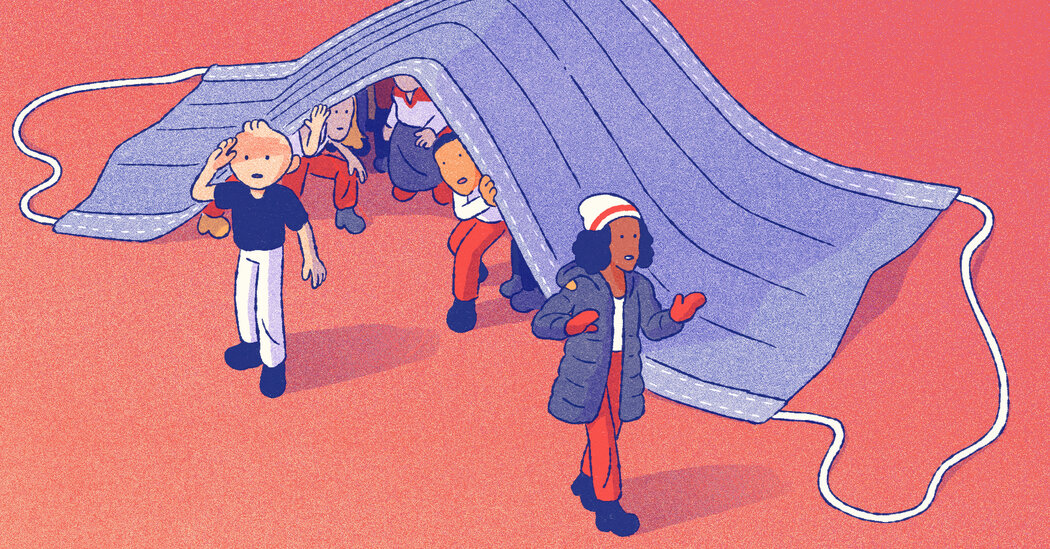
As masking mandates lift and new coronavirus infections fall across the United States, there’s lots of confusion about if, and when, to wear a mask.
“This is the hardest thing of all, because it’s not just the risks and benefits to you,” said Dr. Robert Wachter, a professor and the chair of the medicine department at the University of California, San Francisco. “It’s the risks and benefits to the people around you.”
One good way to frame the issue is to ask: Who is the most vulnerable person in your immediate circle?
If you have compromised immunity, for example, or live with someone who does, it’s a good idea to continue to wear a mask and maintain social distance around strangers, especially in indoor areas with standing air where the virus may collect. Masks are also important if you’re unvaccinated or spending time with others who are unvaccinated. Unvaccinated people are at overwhelmingly higher risk of hospitalization and death from Covid-19. Masks are also a must in hospitals, where there are many vulnerable people.
But if you’re otherwise healthy and have received your vaccine and booster shots, your risk of getting seriously ill with Covid is extraordinarily small. It’s about in line with other risks people take every day, such as driving in a car.
Many people “are weighing the fact that they would love to go back to normal and may be willing to accept a little bit of risk in order to gain a level of simplicity that they last knew in 2019,” Dr. Wachter said. “That’s not irrational.”
There’s also always the risk that someone may develop long-Covid, even if they are vaccinated, though much about the condition remains unknown.
If infection rates where you live are high, which has been pretty much everywhere during the latest Omicron wave, the Centers for Disease Control and Prevention continues to recommend masks in most indoor spaces. But in many situations, the decision to wear a mask is becoming a personal one.
We spoke to experts to help give you a guide to the places, and the situations, where it’s a good idea to cover your face.
Should you mask outside?
There’s little scientific evidence to show that face coverings offer much added protection in many outdoor spaces such as sidewalks or parks. Things get a little hairier with crowds, like at a concert or sports venue.
“If you can’t feel wind on your cheeks, you’re probably not in an area of great outdoor ventilation,” said Dr. Asaf Bitton, a primary care doctor who is the executive director of Ariadne Labs, a public health innovation center at Brigham and Women’s Hospital and the Harvard T.H. Chan School of Public Health. “If you’re really shoulder-to-shoulder with people, that might be a case of outdoor mask wearing, at least for now.”
Erin Bromage, an associate professor of biology who studies infectious diseases at the University of Massachusetts Dartmouth, has helped touring music bands assess Covid risks throughout the pandemic. The main place he’s seen risk of transmission in concerts is in the standing-room-only area close to the stage.
“Where the risk is mainly focused is the pits at the very, very front of the stage where people are on top of each other singing, physically exerting,” Dr. Bromage said.
Most outdoor concerts, though, are generally safe, he said. “If you’re standing on a lawn watching a show, there’s really no data to support that a mask does anything to protect you that Mother Nature’s not taking care of.”
And if the venue requires vaccines or a recent negative Covid test, you’re in even better shape.
How about indoor spaces, like supermarkets or gyms?
First and foremost, follow the norms and the rules of the business you’re entering. If the sign at the door says “Mask Required,” you don’t want to make retail workers have to enforce policies over which they have no control. Their jobs are hard enough, and everyone can wear a mask with little to no sacrifice.
If the business is mask optional, consider the space, the crowds and the airflow.
Dr. Bromage suggests a cigarette analogy: If someone were smoking, would the smell and taste of cigarettes quickly fill the air? If yes, so would the virus. You’d be smart to wear a mask. If not, it’s unlikely that you’ll get infected.
“When I walk into a space, I always do that,” Dr. Bromage said. “How high are the ceilings? Is the air moving? Can I create my own little buffer of space?”
Take a big box store with high ceilings. “Those tend to have good ventilation and because of the high ceilings, there’s a lot of dilution,” said Linsey Marr, an engineering professor at Virginia Tech who studies the airborne transmission of viruses. “The risks are pretty low, unless you’re in a crowded line waiting to check out.”
“If it’s a smaller space and crowded space, Trader Joe’s, for example, or some New York market with tiny aisles and people are really packed in there, the risk is higher,” she continued. “You might want to wear a mask.”
A hair salon might be a small space, Dr. Bromage said, but there typically won’t be that many people inside the business, so the risk of an infected person passing through will generally be low, especially as case counts fall.
At a restaurant, one person’s cigarette smoke at the next table over wouldn’t fill the air above yours. But you would smell someone smoking at your own table, so your direct dining companions pose the highest risk, Dr. Bromage said.
The gym may feel especially scary. Heavier breathing can expel more virus particles, but most gyms have excellent ventilation systems. (“If gyms did not have good air circulation, they would stink,” Dr. Bromage said.) That means any virus particles that may be floating around are also being sucked away with the sweat smell.
Dr. Bromage again uses the cigarette analogy. He’d run on the treadmill unmasked, but he’d put an extra treadmill between himself and another runner. But a spin class, in a small room with “people shouting, yelling, huffing puffing”? Probably not yet, he said.
What about on public transit or airplanes?
Public transit is exempt from local mandates: You are still required to wear a mask, per federal requirements.
It’s also just a good idea — on buses and subways, there are a lot of strangers moving in and out of a tight, enclosed space.
The Coronavirus Pandemic: Key Things to Know
“That is somewhere I would probably still wear a mask,” Dr. Marr said.
On airplanes, you should definitely wear a mask. There’s no national mandate requiring airline passengers to be vaccinated, so even if you’re vaccinated, you don’t know the status of the people around you.
Also, you don’t want to ruin your vacation or business trip by becoming infected and having to quarantine, even if your risk of becoming seriously sick remains low.
What about when my child goes to school?
Public health experts agree that school mask mandates should not last forever, but they differ on whether the time has come to remove them. For parents, changing rules can be confusing.
Here are a few things to consider in making the choice for your own family.
Children almost never suffer severe symptoms, whether or not they’re vaccinated. Many students have gone to school without masks during the pandemic — like in Britain, part of Europe and many U.S. states — and very few children have gotten seriously sick.
“The risk to children has always been lower than it is to adults,” said Dr. David Rubin, a professor of pediatrics at the Perelman School of Medicine at the University of Pennsylvania.
The jury is also still out on whether masks impede social development. But several studies do suggest that a mask makes communication difficult, inhibiting children’s ability to recognize one another or each other’s emotions.
“Children and their schools have had to shoulder a collective burden, largely to protect the adults in their lives,” said Dr. Rubin, who is also the director of PolicyLab at Children’s Hospital of Philadelphia.
And as much of the world opens up, consider all the ways children hang out with each other. Masks may stop transmission in the classroom itself, but children interact outside of school hours.
“Masks don’t work when people are wearing them in one circumstance, but later that day, they take them off,” said Dr. Bromage, who has consulted with schools about different mask policies. “All we’re doing is transferring infection from the school to after school.”
Also, know that the United States is an outlier in its devotion to pediatric masks. The World Health Organization does not recommend them for kids under 5, and the European Centre for Disease Prevention and Control doesn’t recommend them for children under 12.
What if you have the sniffles?
Covid is not the only bug floating around, nor is it the only one that can be harmful to vulnerable people. The flu, for example, kills more than 30,000 Americans in a typical season, most of whom are older adults or immunocompromised.
“Flus and colds are probably transmitted the same way as Covid,” Dr. Marr said. “If you feel a little sick, then you could be shedding virus into the air and transmitting to other people. You should stay home or, if you must go out, wear a mask.”
And what type of mask should you wear?
A well-fitting, high quality mask will protect you, experts say, even if other people aren’t covering their airways.
KN95, N95 and KF94 masks are the best protection around, just make sure they’re not counterfeit. Cloth masks offer limited protection — especially if you don’t add a filter or a second mask — and surgical masks often gape.
Here’s a Wirecutter guide to buying N95 and KN95 masks, and here’s how to spot a fake.







